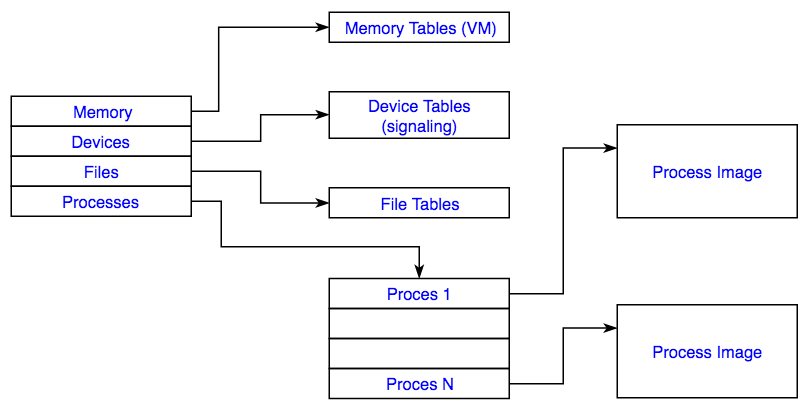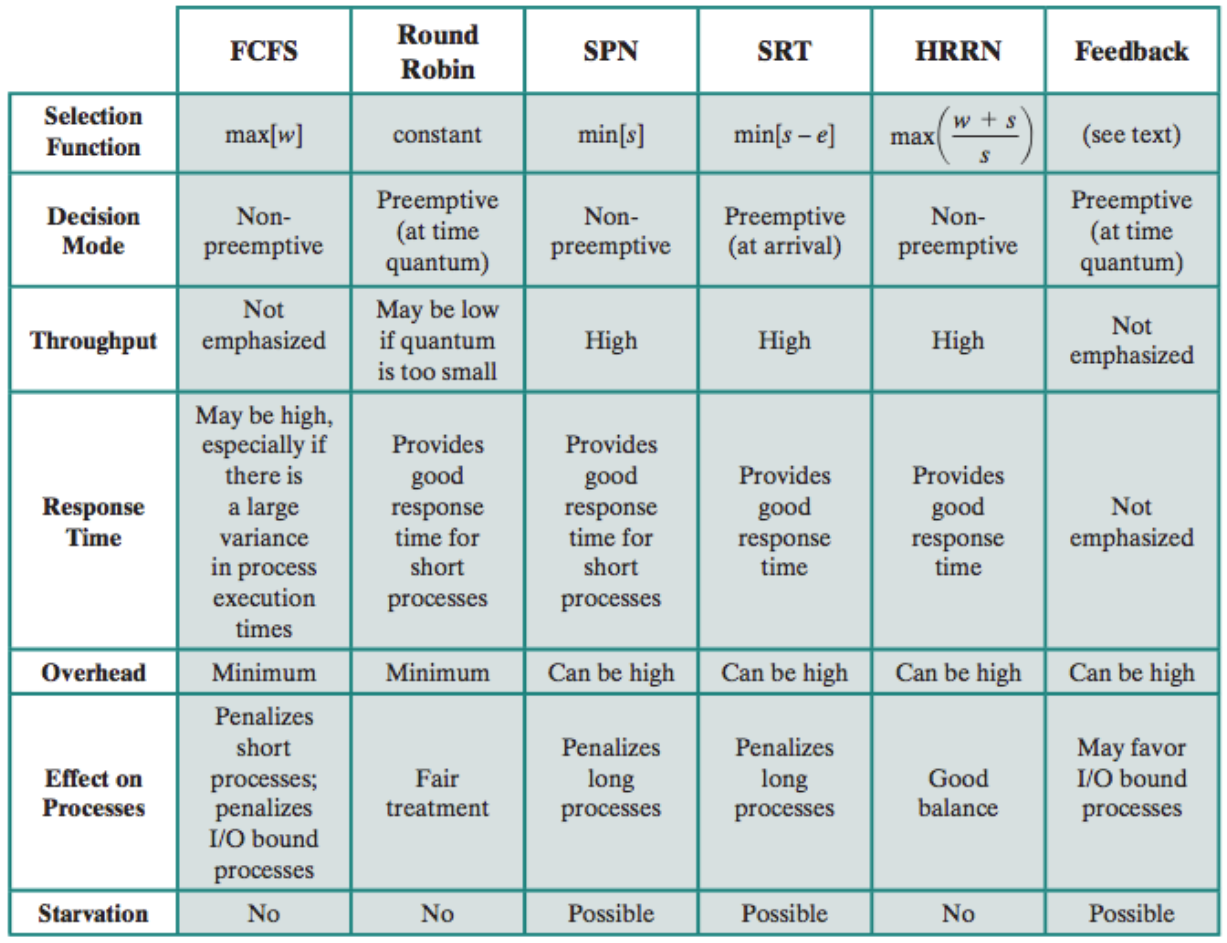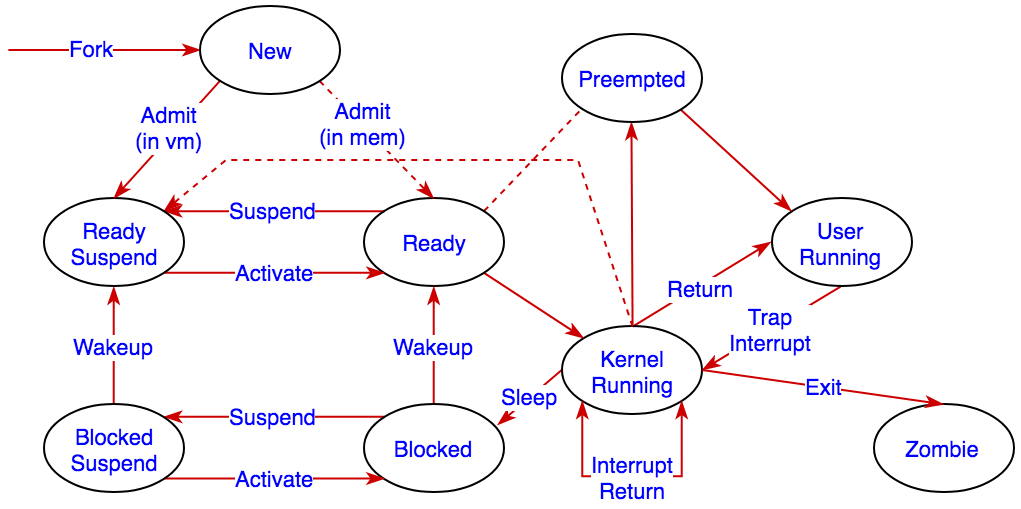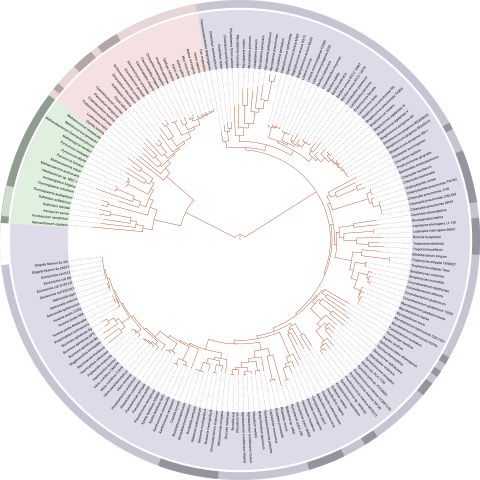Processes
A process is
- An executable program (i.e. ISA instructions)
- data used by that program (variables, stack, buffers, etcetera)
- an execution context = current state
The OS maintains administration of many aspects including:
- pending I/O
- resources sharing or exclusively using
Resource & Process Management


- Memory tables (partly discussed for VM)
- I/O tables used to keep track of all ongoing I/O activity
- File tables contain information of the location and other properties of the hierarchical file system
- The process table contains information (state etc) on all known processes
Process Table
- User Program + Data (e.g. Stack)
- Process Control Block
- ID’s (this, parent, user)
- Processor State
- User-Visible Registers inc Stack Pointers
- Control & Status (PC, Flags, Interrupt masks)
- Process State
- State, Prio, Scheduling Info, Blocking Event
- Data structures e.g. all waiting
- Interprocess Communications e.g. semaphores
- Privileges e.g. root, quota
- Memory Mngmnt
- Resource ownership & Utilization (files, CPU use statistics)
Memory Management
OS responsibilities:
- Process isolation: programs should not be able to inspect or alter data from other programs (unless they are sharing data)
- Access control protection: mechanisms are in place to allow programs to share memory (in the entire hierarchy)
- Automatic allocation and management: Allocation in the hierarchy should be automatic and transparent to the programmer
- Process relocation: processes may need to be relocated (e.g. for swapping)
- Question: how is that possible?
- Modular programming support: creation, destruction and change of program modules
- Persistance: access to long term storage
Information Protection
- Availability: an information service must be accessible for intended use (think of DDOS)
- Confidentiality: information must be accessible to intended parties and not to others (think of phishing)
- Integrity: information should only be altered by intended processes (e.g. XSS)
- Authenticity: information sources (when intended to be accessible) should be true (think of spoofing)
- Accountability: all changes can be traced to identities
Scheduling
which process gets access to the two main resources: CPU and memory?
- Long term scheduling: add to the pool of ready or suspended processes (allow into virtual memory)
- Medium term scheduling: add to the pool of ready or blocked processes from suspend (allow into memory)
- Short term scheduling: add to the pool of running processes (allow into CPU)
- I/O: management sleep/wakeup for I/O
Scheduling Goals
- Fairness: the current Linux scheduler is called ‘Completely Fair Scheduler’, which uses a red-black-tree (a self-balancing binary search tree) to maintain a timeline for every process adding real or virtual (when waiting) nanoseconds towards priority.
- Differential Responsiveness: individual applications may need priority (phone=>real-time scheduler, first-person shooter=> works better in windows)
- Efficiency: max throughput, min response time, min overhead
These goals are often conflicting
Short-term scheduling aka Dispatch
which ready process to execute next?
- invoked very frequently:
- clock interrupts
- I/O interrupts
- OS calls (traps)
- Signals (e.g. semaphores)
- criteria
- priorities
- responsiveness
- throughput
- qualitative criteria such as predictability


- first come first serve
- shortest process next
- shortest remaining time
- highest response ratio next (user info or past experience)
- feedback: give lower priority to long-running processes
Process State


Represents whether a process can run (or possibly why not). The book builds up to the seven state model, but we’ve added two here for run-level and preemption state.
- New: process has just been created
- Ready/Suspended: ready process is moved to disk to free up memory
- Ready: process is ready in memory waiting for CPU and not for I/O
- Running: process is currently active in the CPU
- User state
- System state
- Preempted
- Blocked: process is waiting for I/O
- Blocked/Suspended: has been moved from memory to disk
- Zombie: finished, no resources but still in table (for parent)
Termination
- Normal completion
- Time limit exceeded
- No memory
- Bounds violation
- protection violation
- Arithmetic error
- Time overrun
- I/O error
- Invalid instruction
- Privileged instruction
- Data type error
- Intervention (e.g. deadlock)
- Parent terminated
- Parent request
Processes vs Threads
Process:
- ‘Owns’ resources
- Scheduling/Execution
But these are independent!
- Just execution: Thread
- Also resources: Process
Process has
- Virtual address space (& mem)
- Processor-time
- Access to other processes, files, I/O
Thread has
- State (PC, registers)
- Stack with local variables
- (Shared) access to process resources
Threads are ’light’, Processes are ‘heavy’
Thread Uses
- Foreground (UI) / Background (Logic, Data)
- Async
- Modularity
- Parallelism
Thread Types
- User-level threads
the application manages (using a thread library). The kernel doesn’t ‘see’ threads (only the entire process has a state).
advantages: no mode switch, application specific scheduling, OS indep.
disadvantages: one blocks all, no multiprocessing,
- Kernel level threads: the kernel does management
main disadvantage: mode switch (can result in a factor 10 penalty)
Some OS’s combine ULT & KLT
